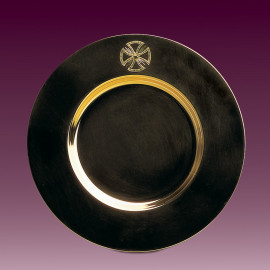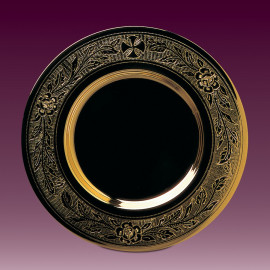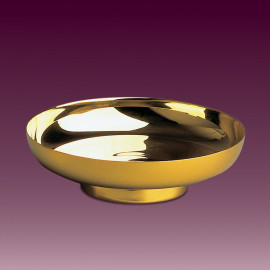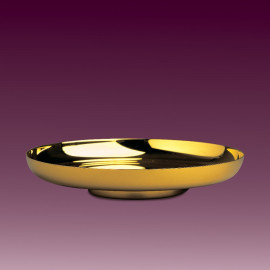No products
Product successfully added to your shopping cart
There are 0 items in your cart. There is 1 item in your cart.
Patens
- Altar Bell and Gong
- Candle Snuffer
- Candlestick
- Catholic Pyx
- Chalices
- Church wall lamps
- Ciborium
- Crosses and Crucifix
- Cruets & Trays
- Holy Water Font
- Holy Water Pot
- Missal Stand
- Monstrance Tabor
- Monstrances
- Offering Baskets
- Oil Stock
- Patens
- Reliquaries
- Sanctuary Bells
- Sanctuary Lamp
- Sprinkler
- Thurible, Boat, & Spoon
- Travel Liturgy & Mass Kit
A paten, also known as a diskos in the Eastern Orthodox and Byzantine Rite Catholic Churches, is a small plate used during the Mass to hold the bread that will be consecrated during the Eucharist. The paten is typically made of precious metal, such as gold or silver, and is often highly decorated. It is used during the liturgy itself, while the reserved sacrament is stored in the tabernacle in a ciborium. The paten is an important part of the Eucharistic celebration and is used to hold the bread that will be consecrated during the Mass. It is also used in Anglican and Lutheran churches, as well as in the United Methodist Church during the Order for the Ordination of Elders. The paten should be large enough to hold the bread that will be consecrated and distributed during the Eucharist. Patens are available for purchase online from a variety of retailers that specialize in church supplies.
A paten, also known as a diskos in the Eastern Orthodox and Byzantine Rite Catholic Churches, is a small plate used during the Mass to hold the bread that will be consecrated during the Eucharist. The paten is typically made of precious metal, such as gold or silver, and is often highly decorated. It is used during the liturgy itself, while the reserved sacrament is stored in the tabernacle in a ciborium. The paten is an important part of the Eucharistic celebration and is used to hold the bread that will be consecrated during the Mass. It is also used in Anglican and Lutheran churches, as well as in the United Methodist Church during the Order for the Ordination of Elders. The paten should be large enough to hold the bread that will be consecrated and distributed during the Eucharist. Patens are available for purchase online from a variety of retailers that specialize in church supplies.
Patens There are 6 products.
Understanding the Church Paten: A Sacred Vessel
The church paten is a small, often ornate, plate that holds a place of reverence in Christian liturgical practices. This sacred vessel is integral to the celebration of the Eucharist, a central rite in many Christian denominations. The paten's primary role is to hold the bread that will be consecrated and transformed into the Body of Christ during the Mass.
The Historical Significance of the Paten
Tracing its roots back to the early days of Christianity, the church paten has evolved both in design and use. Initially, patens were large enough to collect the offerings of bread from the faithful and to distribute the consecrated fragments to the communicants. Over time, as the frequency of receiving Holy Communion declined, the paten's size was reduced, and it took on the form we are familiar with today.
The Paten's Role in Liturgical Celebrations
During the liturgy, the paten is used to hold the bread before and after it is consecrated. In the Western tradition, the paten is typically a simple, saucer-like plate, often made of precious metals like gold or silver, and sometimes gilded on the inside. The Eastern Orthodox and Byzantine Rite Catholic Churches refer to the paten as a diskos, which is usually more ornate and elevated by a stand permanently attached underneath.
The Symbolism Behind the Paten
For Christians, the paten is more than just a plate; it symbolizes the Ever-virgin Mary, who bore Christ into the world, and the Tomb of Christ, from which He resurrected. It represents the entire Church, both the Church Militant and the Church Triumphant, gathered around Christ.
The Paten in Different Christian Traditions
While the use of the paten is widespread across various Christian denominations, there are some differences in its application. For instance, in the United Methodist Church, the paten is presented to newly ordained elders as a sign of their ability to celebrate the Sacraments. In the Roman Catholic Church, the General Instruction of the Roman Missal specifies that the paten should be retained to avoid the danger of the sacred host or fragments falling.
The Artistry and Craftsmanship of Patens
Throughout history, patens have been crafted with great care and artistry. Medieval examples show a marked central depression surrounded by ornamental lobes, while modern patens tend to be simpler, focusing on the symbolic value rather than elaborate decoration. The craftsmanship involved in creating these vessels is a testament to their importance in the liturgical life of the Church.
FAQs About the Church Paten
What materials are used to make a church paten?
Church patens are traditionally made from precious metals such as gold or silver. They may also be gold-plated or made from other materials considered precious in a particular region.
How is the paten used during Mass?
The paten is used to hold the bread that will be consecrated during the Eucharist. It is placed on the altar during the celebration of the Holy Eucharist and is an essential part of the liturgical setup.
Does the paten have to be consecrated?
Yes, the paten, like the chalice, must be consecrated with chrism by a bishop before it can be used for the Eucharist.
Are there different types of patens?
Yes, there are variations such as the communion paten, which is held under the chin or hands of the communicant to catch any particles of the host. The design and size may vary depending on the tradition and specific liturgical needs.
Can anyone handle the paten?
Typically, only consecrated ministers or altar servers are allowed to handle the paten during the liturgy. This is to maintain the reverence and sanctity of the vessel.
In conclusion, the church paten is a vessel of deep religious significance, embodying centuries of tradition and devotion. Its presence on the altar is a silent, yet powerful reminder of the sacred mysteries celebrated during the Eucharist.






